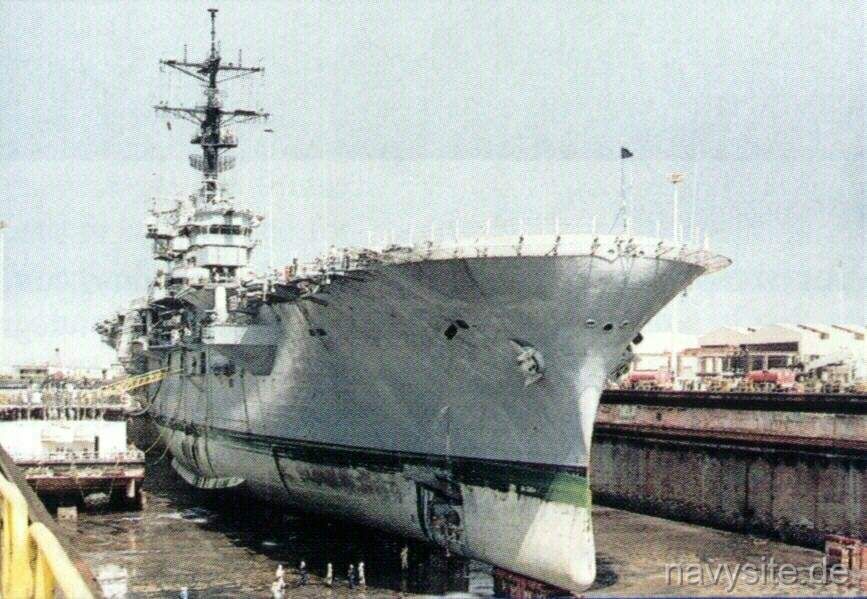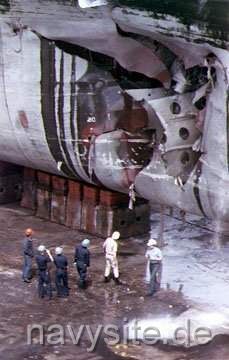I'm a moron.
There is a "right" way to do this, and it's obvious. And as if it wasn't obvious enough, TLAM pretty much nudged me in that direction already... Torpedo damage scaling can be done in exactly the same way as missile damage scaling: fitting a formula to the data. Yes, the data. While only two ships have been sunk with torpedoes since WWII, the WWII data is still helpful, and there have been a number of mine hits as well. This gives us all we need. Here are the data points:
1. USS Samuel Roberts
Hit by Iranian M-08 contact mine. (115kg charge)
Description of damage:
Quote:
|
An eighth of a ton of TNT violently transformed into heat and vapor and soot. The shockwave hit the ship at frame 276 — two-thirds of the way down the 445-foot hull, and just four feet to port of the centerline. The blast lifted the entire ship at the point of impact, and the stern rose a few feet more than the bow. The stress was more than the keel could endure.” A fireball burst up from the damaged engine room as scalding gases melted its equipment and vented up through the ship’s exhaust stack. Its back broken and its crew stunned, the Roberts was dead in the water. Water was flooding into the ship’s engine compartments, and a raging fire was consuming the stricken vessel’s fuel tanks. As Peniston captures it, “In a heartbeat, a single low-tech weapon had roughly halved the structural strength of a U.S. Navy warship.”
|
Quote:
|
The explosion broke the ship's keel and blew a hole in the hull beneath the waterline. Superheated gases tore through the ship's exhaust vents until a fireball burst from the ship's stack, lighting fires on four decks. The engineroom and one auxiliary machinery space flooded immediately. A third space began to fill — threatening to send the ship to the bottom.
|
Quote:
|
In the main engine room, seawater rushed in through the gaping hole. Within 15 seconds water was just 2 feet below the upper deck plates. The blast rendered the main shaft inoperative and ruptured the shaft seal, which allowed the water from the engine room to completely flood [Auxiliary Machinery Room 3] in 5 minutes.
|
Quote:
|
Over the next five hours, the crew of the Roberts labored to stanch the flooding and extinguish fires on four decks.
|
Quote:
No U.S. warship since the Korean War has come closer to sinking in hostile action.
|
Quote:
|
The explosion blew a 15- by 20-foot hole, in the hull
|

Although this is a contact mine, it struck near the keel, so for our purposes this is considered an under-the-keel impact instead of a side impact. The severity of the damage looks to be about 90-95%+.
2. USS Tripoli
Hit by Iraqi LUGM-145 floating contact mine (200kg charge)
Description of effects:
Quote:
|
The explosion ripped a 20 by 30-foot (9 m) hole in the ship's hull and injured four sailors. After 20 heroic hours of damage control, the ship was stabilized and was actually ready to resume operations.
|
Quote:
|
USS TRIPOLI hit a moored Iraqi contact mine creating an explosion and ripping a 16 by 20 foot hole below the water line.
|
Quote:
|
The force of the blast immediately vaporized all of the paint and flammable material creating a very heavy, explosive mist that permeated the forward quarter of the ship. Any spark or other source of heat would have caused this mixture to explode resulting in catastrophic damage and probable loss of the ship."
|


There is some discrepancy about the size of the hole, but the larger estimate is from Wiki so I consider the smaller estimate more reliable (and more reasonable looking at the photos). This figure puts the size of the hole just slightly larger than that caused by the much smaller mine that hit the Roberts, which gives us a good estimate of the difference between a side impact and UTK impact. The last account suggests that the Tripoli got a little lucky; if there had been a fire the damage would have been much worse. So, this example probably understates the damage because fire damage is NOT included. I'd put the actual DW damage around 25%-40%, with an expectation of 33%-50% for a "normal" hit.
3. General Belgrano
Hit by two MkVIII torpedoes (353kg charge)
Description of effects:
Quote:
|
One struck abreast the boiler room, while the second hit 5 seconds later and severed the bow. ... The bow hit was very survivable, but the first torpedo hit in the worst possible place on the cruiser's hull: right between the two biggest compartments on the ship. General Belgrano lost all power instantly, and several fires flared up....But from the very start it was obvious that the ship was doomed. Damage control was hampered by the large number of trainees in the ship's crew, and by the fact that the ship's commander, Captain Héctor E. Bonzohad, had stood his crew down from action stations...The cruiser took on a rapid list to port, and the order to abandon her was given [about 24 minutes after it was fired on]
|
Quote:
One of the torpedoes struck between 10 and 15 metres back from the bow, outside the area protected by either the ship's side armour or the internal anti-torpedo bulge. The effect of this was to blow off the bow of the ship, but the internal bulkheads held and the forward powder magazine for the 40 mm gun did not detonate. There was no-one in that part of the ship at the time of the explosion.
The second torpedo struck about three-quarters of the way along the ship, just outside the rear limit of the side armour plating. The torpedo punched through the side of the ship before exploding in the after machine room. The explosion tore upward through two messes and a relaxation area called "the Soda Fountain" and finally ripped a twenty metre long hole in the main deck. Later reports put the number of deaths in the area around the explosion at 275 men. There was no fire after the explosion, but the ship rapidly filled with smoke. The explosion also damaged the Belgrano's electrical power system, preventing her from putting out a radio distress call.
Though the forward bulkheads held, water was rushing in through the hole created by the torpedo and could not be pumped out because of the electrical power failure. The ship began to list to port and to sink towards the bow. Twenty minutes after the attack at 16:24 Captain Bonzo ordered the crew to abandon ship. Inflatable life rafts were deployed and the evacuation began without panic.
|
It's hard to draw much of a conclusion from this ship because the damage seemed so flukey. One torpedo apparently barely hurt. The other was as bad as it could have been. Damage control could have been better...but then again, without working pumps and with at least 3 compartments flooded, would it have mattered?
4. WWII Data (See previous post)
The net is full of examples of light cruisers hit by torpedoes in WWII. As indicated above, at least some light cruisers in WWII had armor and a 'buldge' to make them more survivable against torpedoes. Nevertheless, it seems most CLs hit by a single torpedo were lost. I can't find any examples of CLs that survived two. WWII torpedoes varied in size, but 250-400kg appears typical. They are, on average, larger than modern torpedoes--probably to counter anti-torpedo design features like the that of the Belgrano/Phoenix.
This is enough data to create a damage-per-kg curve. The basic formula is Damage = [A(Warhead)-B(DMR)]*C, where A and B are coefficients and C is the UTK factor. (DMR=Diminishing Marginal Return. It brings down the larger warheads a bit, so 2x warhead size gives you something less than 2x damage). What I'm going to do is adjust A, B, and C until the results fits the data above.
Specifically, I'm looking for these target values:
1. a UTK impact from a 115kg warhead to damage an OHP to 90%.
2. A side impact from a 200kg warhead to damage an Iwo Jima (between the size of a Harper's Ferry and Invincible) to about 40%. It should be slightly higher than the damage for a 115kg UTK detonation.
3. A side impact from a 353kg warhead to cause incapacitating damage (60-80%) to a 12,000 ton ship (about the size of a Slava). A second impact will finish it off.
Once values are fitted to this data, the resulting curve will be applied to all torpedoes.
If you have a reason why these targets should not be used, speak now, or forever hold your peace.